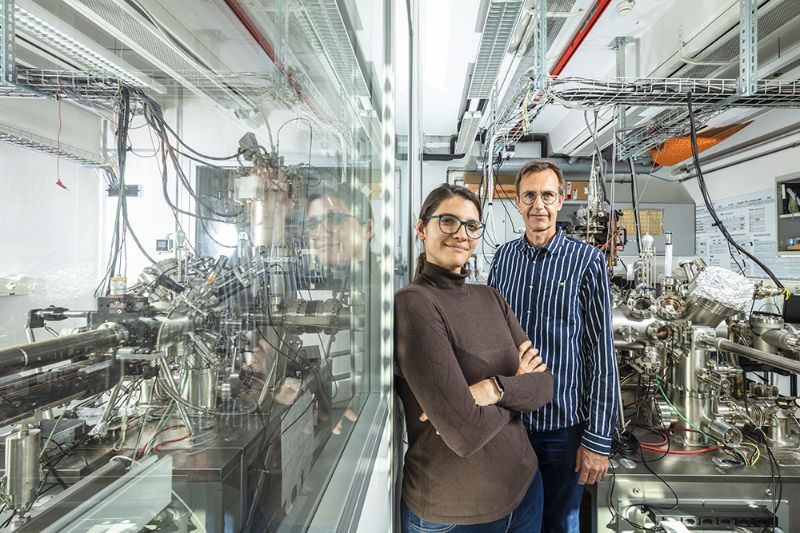“It all comes down to the last atom”
This is one of those wonderful stories from the world of research that bridges the gap between the materials sciences of the past and the quantum sciences of the future. It began in 2003 when researcher Pierangelo Gröning, now head of Empa’s Department of Advanced Materials and Surfaces, came to the institute to set up the nanotechnology department. He was joined by Roman Fasel, now head of the nanotech@surfaces Laboratory: they have known each other since their days at the University of Fribourg, where the physicists researched carbon tubes, the prototype material of nanotechnology.
In 2009, they realised that carbon nanotubes are only suitable to a limited extent for specific electronic applications because the synthesis process cannot be controlled in any meaningful way. Fasel, who had studied molecular structures on surfaces in his dissertation, came up with the idea of trying a controlled production of nanoribbons using molecular building blocks instead of nanotubes – think of it like a set of Lego building blocks made of molecules.
That is when graphene came into play: a modification of carbon with a two-dimensional structure and honeycomb-like pattern. A high-stability material with one disadvantage. “It is not a semiconductor, but a semimetal not useful for many electronic applications,” says Fasel, “unless we succeed in restricting the movement of the electrons in such a way that the semimetal becomes a semiconductor. We did this by synthesising graphene nanoribbons and putting what is known as a band gap into the graphene.” The bands, which are only a few atoms wide, were examined under the scanning tunnelling microscope. It turned out that quantum effects occurred with the reduced dimensionality of the material, and the graphene nanoribbons no longer exhibited continuous, but quantised energy states.
“By adjusting the width of the band,” Fasel explains, “the band gap, the most important property of the semiconductor, can actually be regulated.” From their beginnings with nanotubes, researchers have now found a way to gain complete control over the structure and physical properties of nanoribbons. They can assemble specially designed molecules into any desired band by means of molecular self-organisation and also visualise this down to the atomic structure. “It all comes down to the last atom,” says Gröning. “If one is missing or in the wrong place, the whole thing no longer works.” In 2010, they were able to produce the graphene nanoribbons with atomic precision for the first time.
Energy-efficient and robust quantum technologies
Over the past two years, they have published reports in the journals Nature Nanotechnology, Nature Chemistry and Nature on magnetism in tailored carbon nanomaterials and, in particular, on a physical effect that researchers call spin fractionation. This is formed when many integer spins can be placed in a common, coherent quantum superposition, which is what the Empa scientists managed to do in precisely synthesised molecular chains. These efforts resulted in Empa’s CarboQuant project, which is now being funded by the Werner Siemens Foundation in the amount of CHF 15 million over the next 10 years.
What swayed the Foundation’s decision was that “the geometry of the graphene can be used to adjust its electrical and magnetic properties. The shape, rather than chemistry, determines the properties – a completely new approach.” The CarboQuant project now aims to lay the foundations for innovative, energy-efficient and robust quantum technologies that can also function at room temperature – with today’s materials, this requires temperatures close to absolute zero degrees Celsius.
New possibilities
Several Empa departments are now working on graphene, nanotechnology and quantum science. Mickael Perrin, Assistant Professor at ETH Zurich, is conducting research with an ERC Starting Grant on quantum current transformers – tiny power plants made of graphene ribbons that generate electricity from waste heat through thermoelectric conversion and by exploiting quantum effects.
Another Empa research group led by ETH Zurich Professor Maksym Kovalenko is investigating the synthesis and application of nanocrystals measuring just 3 to 10 nanometres. The group has mastered the synthesis of these crystals to such an extent that they can be produced in an almost monodisperse form. This opens up completely new possibilities in the development of materials: nanocrystals in superlattices with novel properties, potentially suitable for use as an energy-efficient and ultra-fast light source.
